Air & Space 18A Gyroplane, G-BVWL
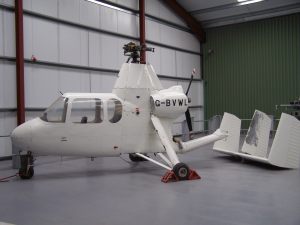 |
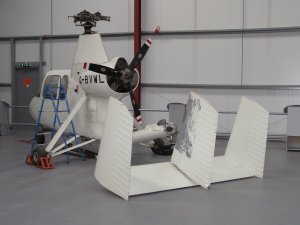 |
|
| Air and Space 18A autogyro, G-BVWL/SE-HIE,
acquired from the Museum of Flight, at East Fortune in Scotland,
was transported to The Helicopter Museum by two Members of the Friends,
arriving on 21st November 2007. It was manufactured in 1966 and
is one of four which were originally registered in Sweden as SE-HIC,
SE-HID, SE-HIE and SE-HHZ. The purchase was funded by The
Museums, Libraries & Archives Council's PRISM Fund. In 1994 SE-HID, serial 18-14, and SE-HIE, serial 18-63, were imported from Sweden to the UK, by a Scottish autogyro enthusiast, re-registered as G-BVWK and G-BVWL respectively and then stored, near Forfar, until transfer to East Fortune in 2004. Both are still essentially complete though the Helicopter Museum's G-BVWL, now in the display hangar, is lacking main rotor blades. |
||
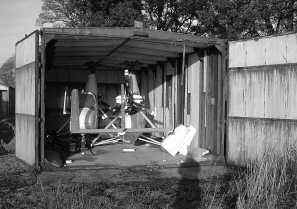 The two Air and Space 18As in storage near Forfar in 2004. Photo via Ian Brown |
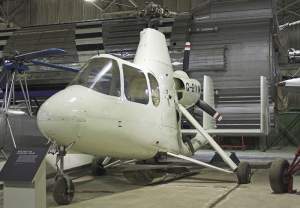 Air & Space 18A, G-BVWK, at East Fortune in 2007. Photograph © Wallace Shackleton. |
|
| Air and Space 18A gyroplanes are tandem two-seaters with the pilot in front. There is optional and limited dual control. Construction is metal semi-monocoque with a steel frame centre section, housing the engine and transmission. The cockpit is fully enclosed and a low-slung tail boom carries a horizontal stabiliser with fixed fins at each end and an all-moving rudder in the centre. The rear cockpit space was designed to be convertible for crop spraying equipment or for cargo. | ||
| The fully-articulated main rotor has three blades made of spruce and balsa wood, reinforced with fibreglass. Drive to the rear-mounted pusher propeller, from the 180hp Lycoming O-360 engine, can be clutched to the lifting rotor, in flat collective pitch, to achieve the required RPM for jump take-offs. When take-off is initiated the rotor drive is dis-engaged and the rotor collective pitch automatically increased to 9.5 degrees to provide the necessary lift, with maximum power re-directed to the pusher propeller. Thus the pilot can choose to make either rolling or jump take-offs. The standard constant-speed propeller is 2-bladed but a rare Farrington modification gave a few machines, including G-BVWL and G-BVWK, a 3-bladed unit. There is a wide track tricycle undercarriage with oleo struts and a fully castoring nose wheel. Ground steering is enabled by differential braking of the two main wheels. | ||
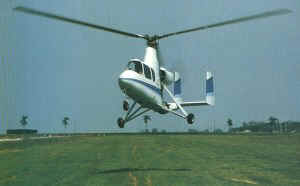 |
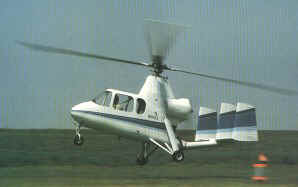 |
|
| Air and Space 18A, N6155S, flying on evaluation trials at Belle Glade Airport, Florida, in 1993. | ||
Type HistoryRaymond E. Umbaugh, a fertiliser manufacturer and rotorcraft enthusiast, who had spent some time modifying Bensen gyroplanes, founded Umbaugh Aircraft Corporation in Florida, in 1957, to develop a new gyroplane. He appointed Gilbert DeVore, previously a flight test engineer with the CAA, to be Chief Engineer and designer. |
||
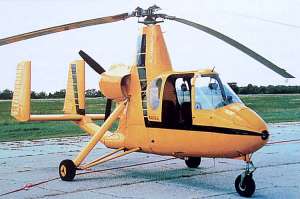 |
The first
prototype, Umbaugh U-17, flew in August 1959. Five development
aircraft were built by Fairchild and the second prototype, the
U-18, was fitted with a V-tail, to improve stability, but soon
found to be unsatisfactory. Sufficient stability was achieved
eventually, on the fourth prototype, with the characteristic two
fixed fins, on either end of a horizontal stabiliser, and a rudder
mounted centrally between the fins. The fifth development machine
was used to gain the FAA Approved Type Certification, in September
1961, and Fairchild agreed to undertake production. The Securities Commission brought accusations of stock irregularities, which were eventually rebuffed, but the delays caused bankruptcy of the company in 1966. Its assets were bought by ex-Umbaugh dealer and Pan Am captain, Don Farrington, of Paducah, Kentucky. In 1972 Farrington and his partner, gyroplane pioneer John Potter, set up Air and Space America Inc. and began purchasing old 18A gyroplanes which they then rebuilt and offered for sale. |
|
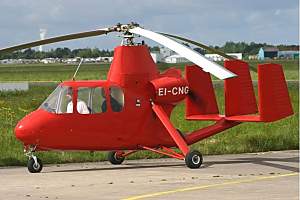 |
||
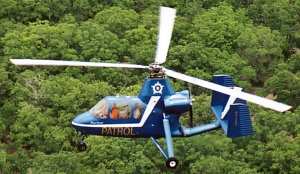 Photograph © www.gyroplane.aero |
||
| For many years Farrington Park, in Kentucky,
was the only gyroplane training centre in the world offering instruction
7 days a week and every day of the year except Christmas. John Potter
trained most of the gyroplane instructors in the USA and others
throughout the world, using the 18A machines for much of the time.
Farrington and Potter developed several supplemental modifications
for the 18A gyroplane including the variable pitch rotor system
and fibreglass engine cowlings to reduce the, always significant,
propeller and exhaust noise. Eventually, having gained the Air & Space 18A Type Certification in 1992, the company made preparations for building a new version of the 18A gyroplane, with a more powerful Lycoming engine. However, on 13th April 2000, Farrington suffered a heart attack while flying an Air & Space 18A, at about 200 feet, at the end of a Florida airshow. The aircraft crashed and Farrington was rescued from the cockpit, not breathing and with no pulse but apparently without injuries. He was rushed to hospital but died ten days later. He was 69. Subsequent examination of the gyroplane showed no evidence of mechanical failure. John Potter moved to LaBelle, Florida, and set up Heliplane Aircraft Corporation International with a partner, Gene Ferrel. He was able to acquire some of the assets from Air & Space America and from the Farrington estate, including a Type Certificate and three 18A gyroplanes, and they started to design a four-seat version. Sadly, before much had been achieved, Potter died of cancer on July 28th 2006, aged 83. Heliplane declared bankruptcy in July 2011. |
||